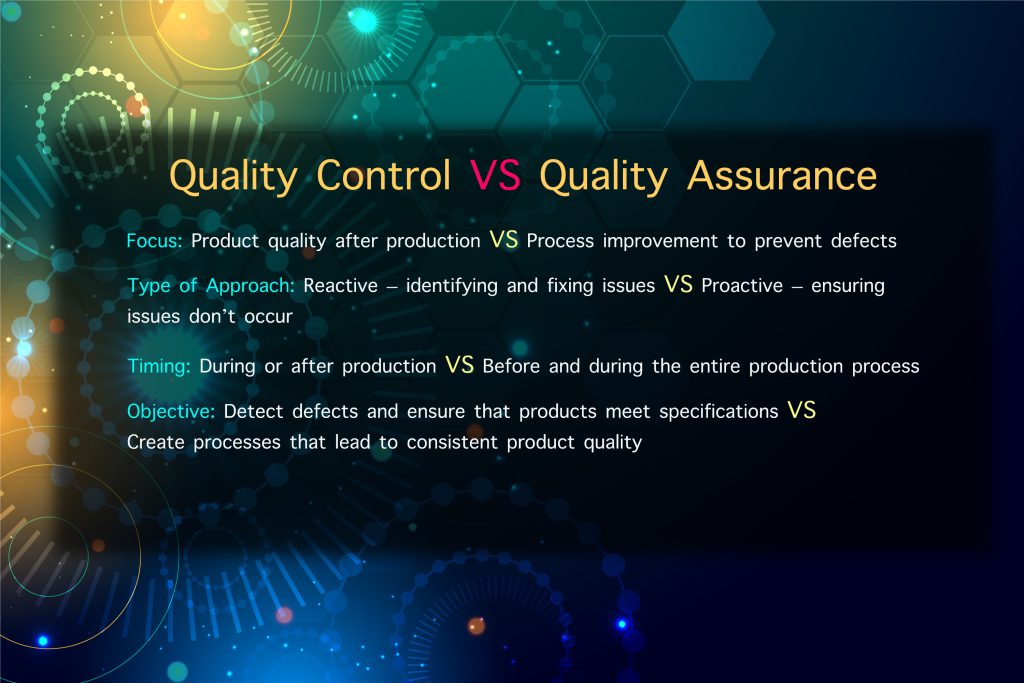In any industry where products are made or services are delivered, maintaining high standards is crucial for ensuring customer satisfaction and minimizing errors. Two essential components of this process are Quality Control (QC) and Quality Assurance (QA). Although often used interchangeably, these concepts have distinct roles in ensuring that the final product meets the desired standards. In this article, we’ll explain what QC and QA are, how they differ, and why both are vital for any business focused on quality.

What is Quality Control (QC)?
Quality Control (QC) refers to the process of identifying defects or inconsistencies in products or services before they reach the customer. It is typically carried out during or after the production process and involves testing, measuring, and inspecting to ensure that products meet the established quality criteria.
The goal of QC is to detect and fix any issues before products are distributed to customers or leave the country of origin, which helps to prevent complaints, returns, or damage to a brand’s reputation. QC can involve various methods, including:
• Inspection of finished products for defects, such as improper dimensions, faulty components, or aesthetic issues.
• Sampling and testing random batches of products during production.
• Measuring performance or functionality to ensure products work as intended.
Examples of QC in practice:
• A manufacturer of electronics tests each device before packaging to confirm it functions properly.
• A textile company conducts final inspections of clothing items to check for stitching defects or fabric inconsistencies.
What is Quality Assurance (QA)?
Quality Assurance (QA), on the other hand, focuses on preventing defects by improving and maintaining processes. QA is proactive and process-oriented. It ensures that quality standards are integrated throughout the production cycle and business operations to prevent issues from occurring in the first place.
QA involves defining standard operating procedures (SOPs), developing checklists, training employees on best practices, and continuously monitoring processes to improve efficiency and effectiveness. The goal is to create a robust system that guarantees the final product meets the required specifications without needing extensive rework.
Examples of QA in practice:
• A company implements a system to ensure that raw materials from suppliers meet specific standards before production starts.
• A software development firm uses standardized coding practices and conducts regular code reviews to prevent bugs in the final product.
Key Differences Between QC and QA
Aspect Quality Control (QC) Quality Assurance (QA)
Focus Product quality after production VS Process improvement to prevent defects
Type of Approach Reactive – identifying and fixing issues VS Proactive – ensuring issues don’t occur
Timing During or after production VS Before and during the entire production process
Objective Detect defects and ensure that products meet specifications VS Create processes that lead to consistent product quality
Tools and Methods Inspections, testing, measurements VS Audits, process monitoring, training, standardization
Why Both QC and QA Are Important
Although QC and QA have different approaches, they complement each other in ensuring high product quality. Quality Control ensures that the final product is free from defects, while Quality Assurance ensures that the processes in place are effective enough to prevent defects from occurring.
For example, if a company only focuses on QC, they may catch defects but may not address the root causes leading to these issues. On the other hand, focusing only on QA without any QC checks could lead to defects slipping through, as errors can still happen despite best efforts to improve processes.
A successful business integrates both QC and QA into its operations to ensure continuous improvement, customer satisfaction, and cost-effectiveness. QA provides the framework, while QC provides the checkpoints to ensure that quality standards are upheld.
Conclusion
Understanding the difference between Quality Control and Quality Assurance is critical for businesses looking to maintain high product standards and improve customer satisfaction. While QC ensures that the final product meets the quality standards, QA works behind the scenes to create processes that prevent issues from occurring in the first place. Together, they form the foundation of any effective quality management system, ensuring that businesses can consistently deliver reliable products and services.
By incorporating both QC and QA into your operations, you can minimize defects, reduce costs, and improve efficiency, ultimately leading to greater success in the market.








